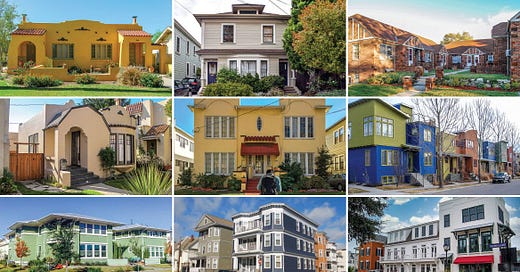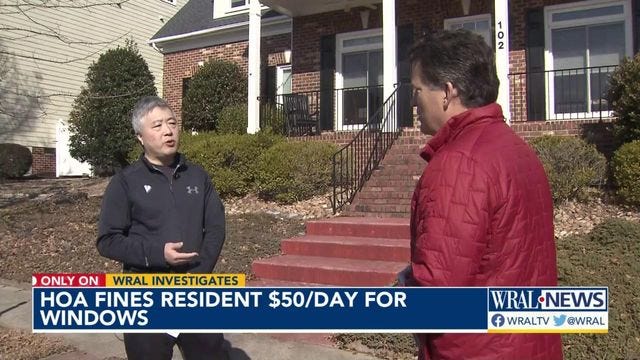A popular concept floating around urbanist1 circles is the idea of the ‘missing middle.’ Most of our built environment is split between single-family homes and denser apartments. In between these housing forms are a wide range of modalities sitting within the range of mid-density. Things like cottage courts, rowhouses, and multiplexes are largely absent from new construction and create sharp cutoffs between apartment and single-family home neighborhoods. This model of development has made it incredibly difficult to build walkable, dense, and transit-oriented cities as no gradient between isolated apartment districts and the sea of single-family homes exists in most cities. Pursuing more of these housing forms is an important step in making neighborhoods that house more people without the drastic changes brought about by the lack of gradation.
The strategy to catalyze more construction of these types of housing is known as infill development. The basic process is to take an existing suburban neighborhood near the denser regions of a city, rezone and incentivize the construction of mid-density housing forms in that region, and over time expand this further out from the city centers. When a single-family home is demolished or goes up for sale, developers would be able to easily build smaller forms of density within the lot size of a standard house. Functionally, this is retrofitting the existing allotment, parking, and road layouts of a suburb and slowly pushing it into soaking up more and more density until a neighborhood befitting of a metropolis is realized. The fact is that a lot of our infrastructure is designed around the suburban model, and instead of ripping out whole neighborhoods and starting from scratch, it’s more financially and materially sustainable to assemble dense and multi-use neighborhoods over time.
In addition to retrofitting suburban infrastructure into urban modalities, we also need to guide suburban lifestyles to function in urban environments. Suburbanites are accustomed to certain expectations of community structure, amenities, and atmosphere. Maintaining a sense of continuity will be necessary to make infill palatable to individuals who have more suburban lifestyle expectations. And one clear aspiration that most Americans wish to see is homeownership.
Urban life and renting are synonymous in the United States. Just as there’s a bifurcation of housing forms, there’s a similar bifurcation of housing economies. If you live in a walkable or transit-oriented neighborhood, the odds are overwhelming that you rent, as the only types of housing available in such neighborhoods are apartments. Since missing middle-style housing is a blend of the infrastructural realities of suburban and apartment life, it could also serve well in bridging ownership arrangements as well. Additionally, building more opportunities for ownership also allows individuals and families to achieve a greater sense of financial and social stability in urban environments2. As communities are retrofitted, we need to identify and pursue housing options that present a diversity of both form and relation to fulfill the needs of as many populations as possible.
There is a material reality complicating this strategy, however. Unlike single-family homes, missing middle housing requires the collective management of assets. With stacked multiplexes, condos, and townhouses there are shared spaces necessary to access one’s unit, such as hallways or utility closets. Even in free-standing structures, like cottage courts, there are often shared social infrastructures and services, like community gardens or snow plowing. Managing these common resources while maintaining individual ownership of units requires some sort of collective governance. Thus, Homeowners Associations (HOAs) are an inevitability in an urbanist future with widespread homeownership.
Unfortunately, HOAs have become a scourge of American suburban life. There are two broad issues with these institutions. One is that they have become a significant source of government privatization. Many HOAs manage trash service, road upkeep, recreational facilities, and even some utilities. Removing these services from the public sphere has taken oversight for critical operations outside of the purview of public ethics and transparency laws. Additionally, this continual erosion of public capacity and responsibility has made HOAs quite politically powerful, as their dissolution would suddenly place large cost and capacity burdens on municipalities. This entrenchment makes oversight and potential future reforms challenging.
The other main problem is that HOAs are in many ways ‘anti-freedom.’ HOAs have the right to enforce a broad array of lifestyle and aesthetic decisions onto their members. They may regulate house color and decorative styles, landscaping choices, and even ban certain vehicles from one’s driveway. So, if you want to have a vegetable garden and a camper for weekend excursions, those activities could be restricted at any moment. This enforcement of conformity is a common result within HOA neighborhoods across the country and has drastically curtailed the ability of individuals to live life on their terms. All of this is enforced by the HOA’s power to fine members and, if they do not fall into line, to eventually foreclose on members’ homes.
If we want to have dense housing while maintaining homeownership, HOAs present a direct impediment to quality of life should such a world be achieved. Thus, HOA reform should become a priority for urbanist activists, particularly at state and local levels. Policies that preserve resource coordination functions but bar the needless policing of lifestyle choices should be pursued.
Limitations should be placed on the kinds of activities HOAs can regulate. I would prefer to limit it to the management of shared spaces (parking lots, hallways, pools, etc.) or safety (use of open flames, ensuring pipes are kept warm in winter). If HOAs want to be involved in regulating other activities, they should not go beyond municipal codes. Therefore, HOAs can crack down on actual nuisances, such as excessive noise or truly unkempt yards, without stepping beyond the bounds of individual liberty. Finally, HOA’s ability to fine and foreclose on members should be tightly controlled, with a strict standard placing an upper limit on fines as well as severely limiting when it is reasonable to foreclose on an individual’s house or condo. Additionally, in these instances, neither the association nor any members should be allowed to bid on a subsequent sale, nor should proceeds, beyond whatever damage a resident caused, be given to the HOA.
Whenever communities share resources there is a need for collective management. If an urbanist future is to be achieved while preserving homeownership, we are going to need institutions like Homeowners’ Associations to finance and govern shared facilities and services. However, to make these communities truly livable we must establish clear boundaries to preserve the autonomy of residents. Without limitations on their power, HOAs have become prime examples of the dangers of democratic overreach. Ensuring checks on these powers is vital to creating vibrant urban communities.
What I’m Reading, Watching, and Listening to
The Problem With J.D. Vance’s Augustine: On the VP’s perverted theology.
Freezer Culture: A fun introduction to rural American food storage practices and worldviews.
The Post-Grazing Party: Very excited to see that one of my favorite artists — Chris Helzer, better known as the Prairie Ecologist — is launching a new photography series documenting how prairies respond to intensive grazing. If it’s anything like his previous photostories, I highly recommend following along.
A movement focusing on improving the quality of our cities. Common focal points include walkability, bikability, housing density, zoning reform, and transit improvements.
This is not to say that we need to continue the current paradigm of housing as a massive source of wealth creation, which conflicts with affordability.






